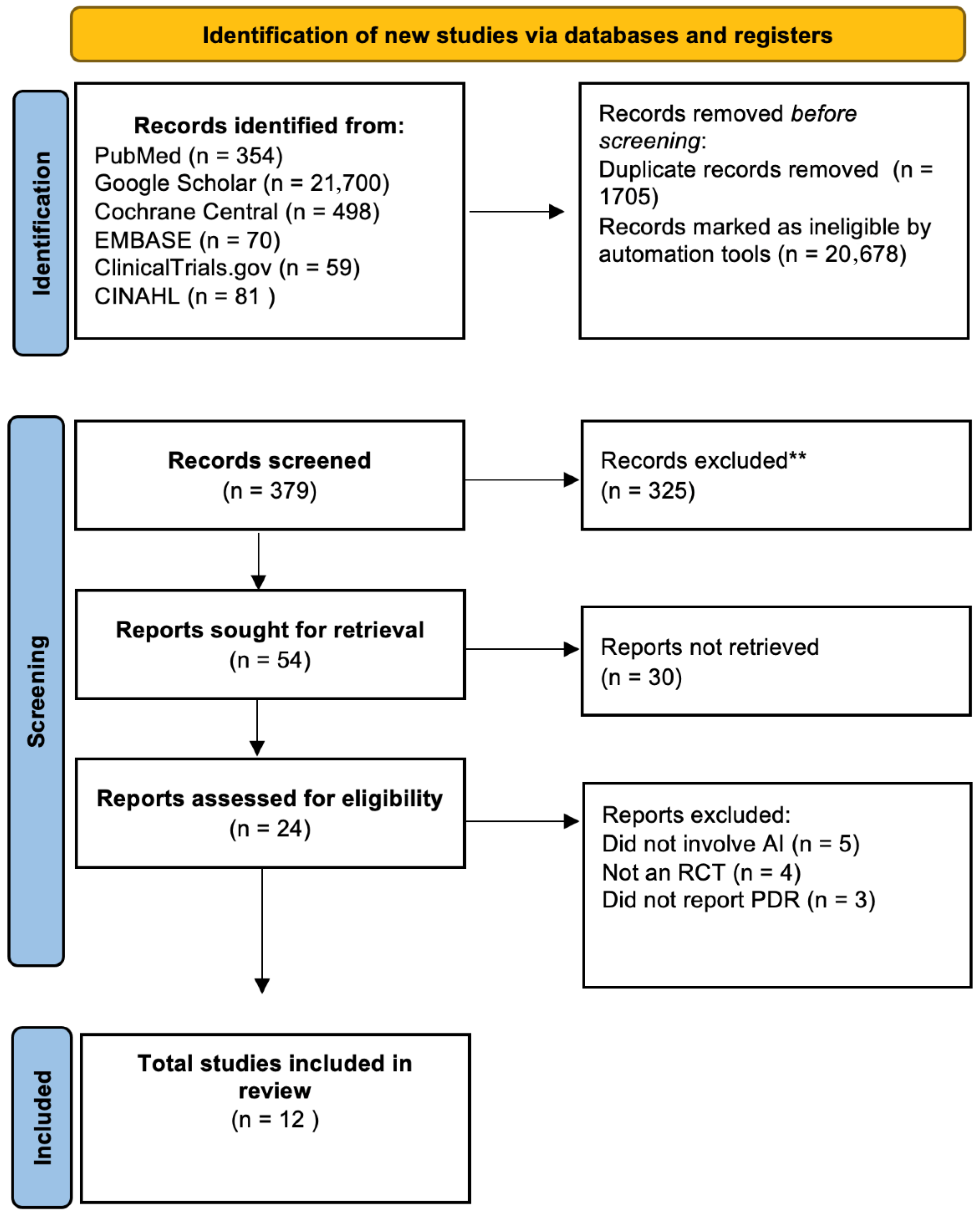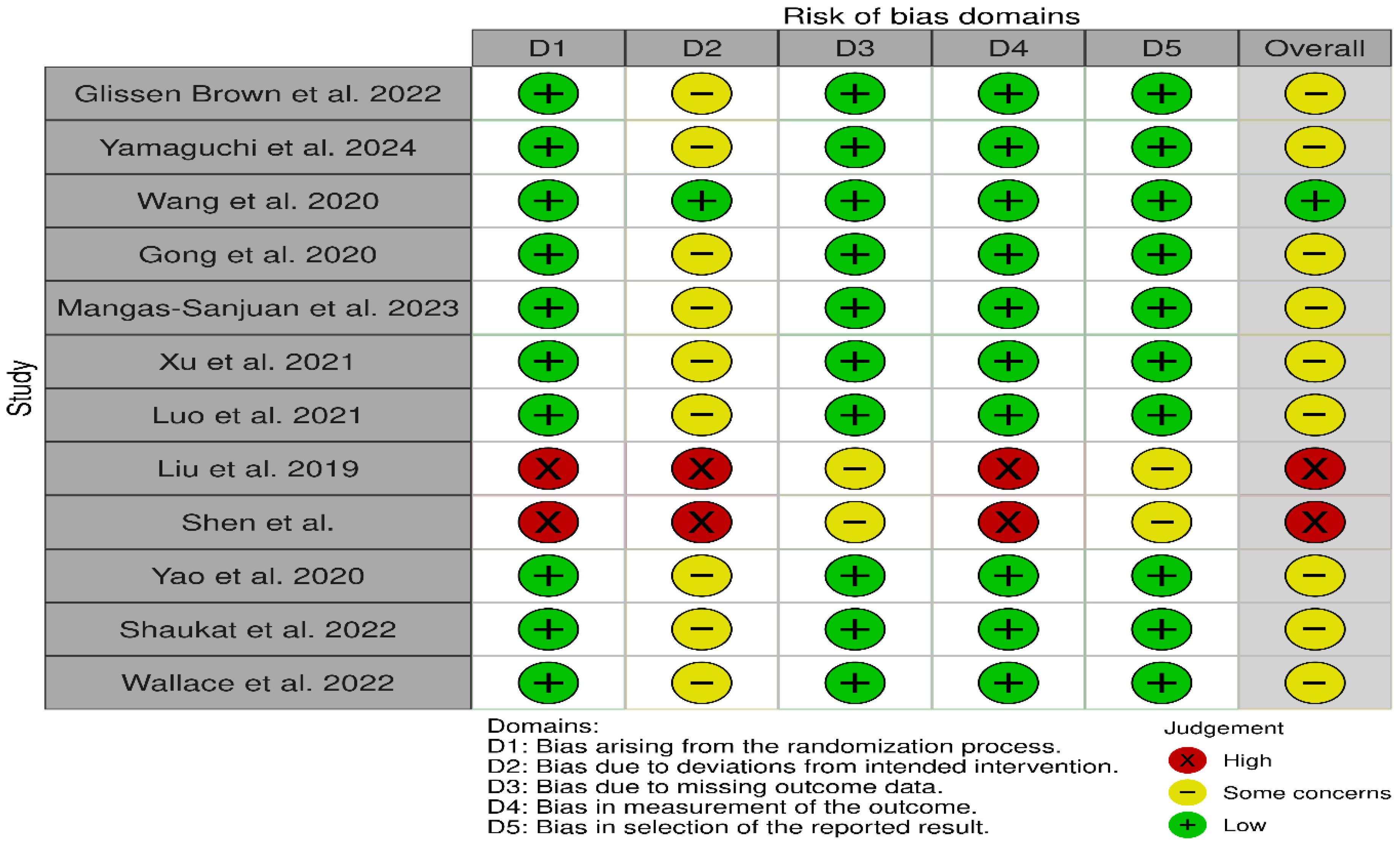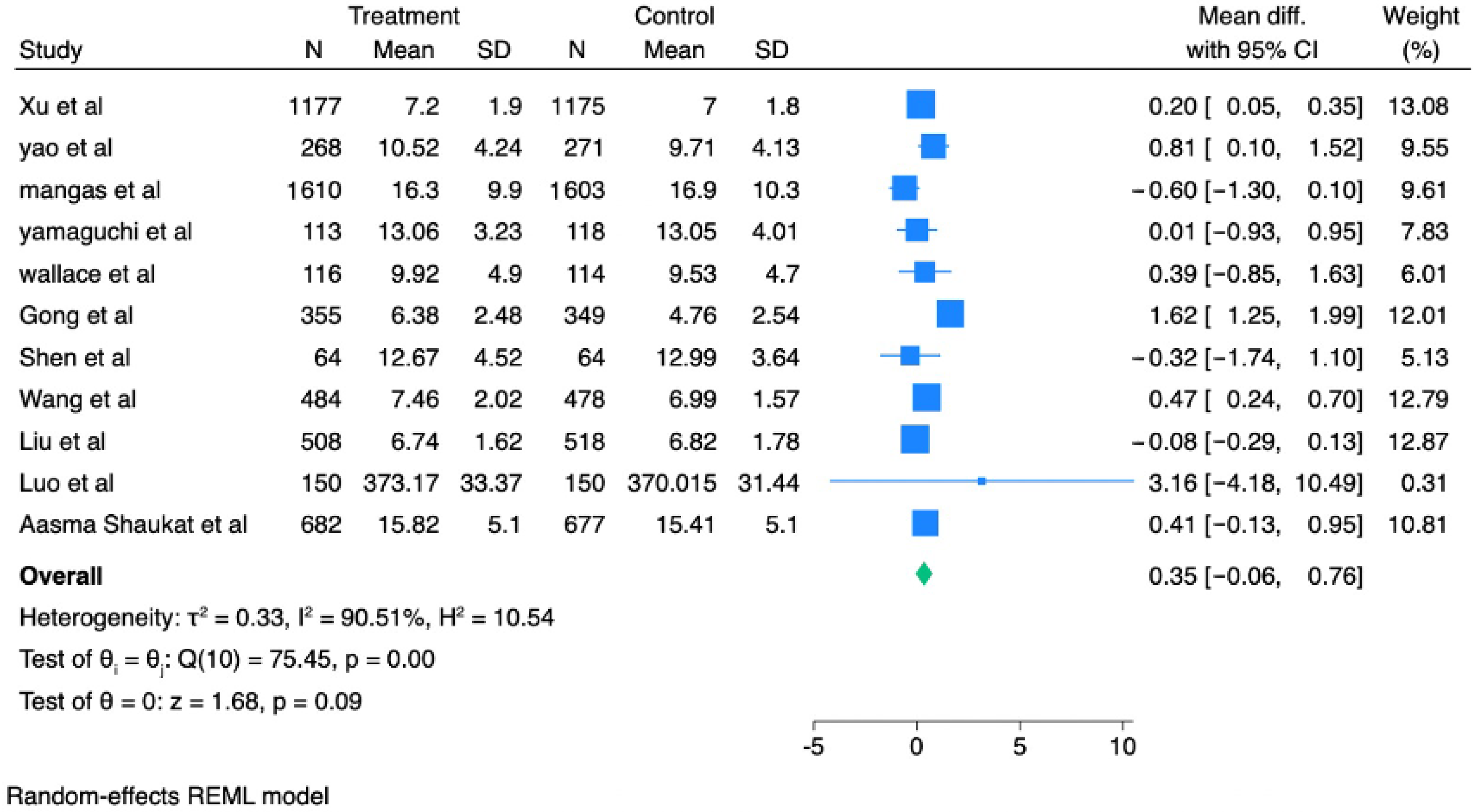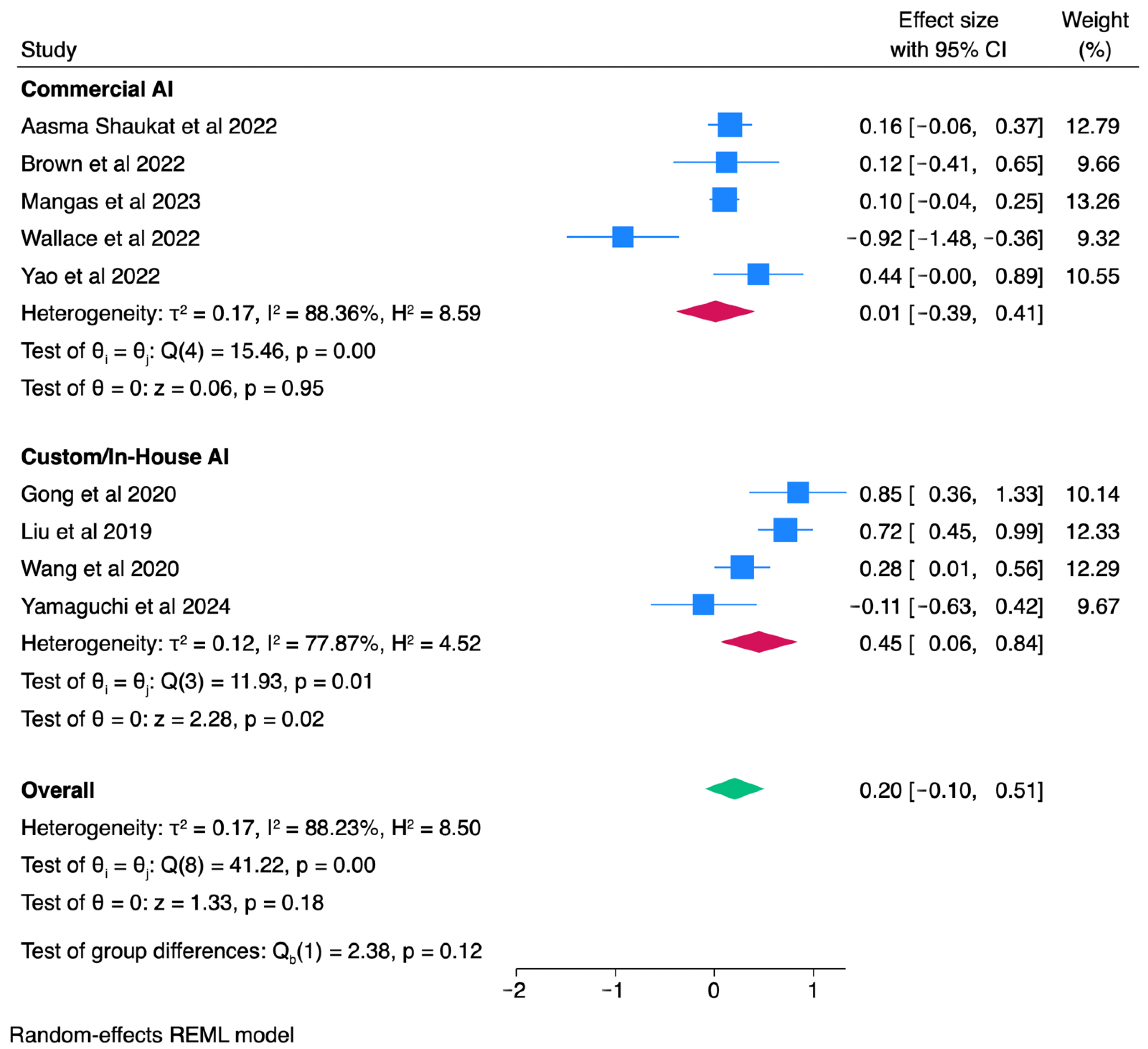Real-Time Artificial Intelligence Versus Standard Colonoscopy in the Early Detection of Colorectal Cancer: A Systematic Review and Meta-Analysis
Abstract
1. Introduction
2. Methods
2.1. Study Design
2.2. Identification of Studies
2.3. Inclusion and Exclusion Criteria
2.4. Data Extraction and Quality Assessment
2.5. Outcomes
2.6. Data Synthesis and Analysis
3. Results
3.1. Study Selection and Characteristics
3.2. Polyp Detection Rate
3.3. Adenoma Detection Rate
3.4. Withdrawal Time
3.5. Subgroup Analyses
4. Discussion
5. Conclusions
Supplementary Materials
Author Contributions
Funding
Institutional Review Board Statement
Informed Consent Statement
Data Availability Statement
Conflicts of Interest
Abbreviations
| ADR | Adenoma Detection Rate |
| AI | Artificial Intelligence |
| CADe | Computer-Aided Detection |
| CI | Confidence Interval |
| CRC | Colorectal Cancer |
| OR | Odds Ratio |
| PDR | Polyp Detection Rate |
| PRISMA | Preferred Reporting Items for Systematic Reviews and Meta-Analyses |
| RCT | Randomized Controlled Trial |
| RoB | Risk of Bias |
| GRADE | Grades of Recommendation, Assessment, Development and Evaluation |
References
- Corley, D.A.; Jensen, C.D.; Marks, A.R.; Zhao, W.K.; Lee, J.K.; Doubeni, C.A.; Zauber, A.G.; De Boer, J.; Fireman, B.H.; Schottinger, J.E.; et al. Adenoma Detection Rate and Risk of Colorectal Cancer and Death. N. Engl. J. Med. 2014, 370, 1298–1306. [Google Scholar] [CrossRef] [PubMed]
- Anderson, J.C.; Butterly, L.F. Colonoscopy: Quality Indicators. Clin. Transl. Gastroenterol. 2015, 6, e77. [Google Scholar] [CrossRef] [PubMed]
- Rex, D.K.; Anderson, J.C.; Butterly, L.F.; Day, L.W.; Dominitz, J.A.; Kaltenbach, T.; Ladabaum, U.; Levin, T.R.; Shaukat, A.; Achkar, J.-P.; et al. Quality Indicators for Colonoscopy. Gastrointest. Endosc. 2024, 100, 352–381. [Google Scholar] [CrossRef] [PubMed]
- Zhao, S.; Wang, S.; Pan, P.; Xia, T.; Chang, X.; Yang, X.; Guo, L.; Meng, Q.; Yang, F.; Qian, W.; et al. Magnitude, Risk Factors, and Factors Associated with Adenoma Miss Rate of Tandem Colonoscopy: A Systematic Review and Meta-Analysis. Gastroenterology 2019, 156, 1661–1674.e11. [Google Scholar] [CrossRef]
- Shaukat, A.; Lichtenstein, D.R.; Somers, S.C.; Chung, D.C.; Perdue, D.G.; Gopal, M.; Colucci, D.R.; Phillips, S.A.; Marka, N.A.; Church, T.R.; et al. Computer-Aided Detection Improves Adenomas per Colonoscopy for Screening and Surveillance Colonoscopy: A Randomized Trial. Gastroenterology 2022, 163, 732–741. [Google Scholar] [CrossRef]
- Anderson, R.; Burr, N.E.; Valori, R. Causes of Post-Colonoscopy Colorectal Cancers Based on World Endoscopy Organization System of Analysis. Gastroenterology 2020, 158, 1287–1299.e2. [Google Scholar] [CrossRef]
- Wallace, M.B.; Sharma, P.; Bhandari, P.; East, J.; Antonelli, G.; Lorenzetti, R.; Vieth, M.; Speranza, I.; Spadaccini, M.; Desai, M.; et al. Impact of Artificial Intelligence on Miss Rate of Colorectal Neoplasia. Gastroenterology 2022, 163, 295–304.e5. [Google Scholar] [CrossRef]
- Hassan, C.; Wallace, M.B.; Sharma, P.; Maselli, R.; Craviotto, V.; Spadaccini, M.; Repici, A. New Artificial Intelligence System: First Validation Study versus Experienced Endoscopists for Colorectal Polyp Detection. Gut 2020, 69, 799–800. [Google Scholar] [CrossRef]
- Wang, P.; Liu, X.; Berzin, T.M.; Glissen Brown, J.R.; Liu, P.; Zhou, C.; Lei, L.; Li, L.; Guo, Z.; Lei, S.; et al. Effect of a Deep-Learning Computer-Aided Detection System on Adenoma Detection during Colonoscopy (CADe-DB Trial): A Double-Blind Randomised Study. Lancet Gastroenterol. Hepatol. 2020, 5, 343–351. [Google Scholar] [CrossRef]
- Repici, A.; Badalamenti, M.; Maselli, R.; Correale, L.; Radaelli, F.; Rondonotti, E.; Ferrara, E.; Spadaccini, M.; Alkandari, A.; Fugazza, A.; et al. Efficacy of Real-Time Computer-Aided Detection of Colorectal Neoplasia in a Randomized Trial. Gastroenterology 2020, 159, 512–520.e7. [Google Scholar] [CrossRef]
- Gong, D.; Wu, L.; Zhang, J.; Mu, G.; Shen, L.; Liu, J.; Wang, Z.; Zhou, W.; An, P.; Huang, X.; et al. Detection of Colorectal Adenomas with a Real-Time Computer-Aided System (ENDOANGEL): A Randomised Controlled Study. Lancet Gastroenterol. Hepatol. 2020, 5, 352–361. [Google Scholar] [CrossRef]
- Moher, D.; Liberati, A.; Tetzlaff, J.; Altman, D.G.; The PRISMA Group. Preferred Reporting Items for Systematic Reviews and Meta-Analyses: The PRISMA statement. BMJ 2009, 339, b2535. [Google Scholar] [CrossRef] [PubMed]
- Sterne, J.A.C.; Savović, J.; Page, M.J.; Elbers, R.G.; Blencowe, N.S.; Boutron, I.; Cates, C.J.; Cheng, H.-Y.; Corbett, M.S.; Eldridge, S.M.; et al. RoB 2: A Revised Tool for Assessing Risk of Bias in Randomised Trials. BMJ 2019, 366, l4898. [Google Scholar] [CrossRef] [PubMed]
- Brown, J.R.G.; Mansour, N.M.; Wang, P.; Chuchuca, M.A.; Minchenberg, S.B.; Chandnani, M.; Liu, L.; Gross, S.A.; Sengupta, N.; Berzin, T.M. Deep Learning Computer-aided Polyp Detection Reduces Adenoma Miss Rate: A United States Multi-Center Randomized Tandem Colonoscopy Study (CADeT-CS Trial). Clin. Gastroenterol. Hepatol. 2022, 20, 1499–1507.e4. [Google Scholar] [CrossRef] [PubMed]
- Yamaguchi, D.; Shimoda, R.; Miyahara, K.; Yukimoto, T.; Sakata, Y.; Takamori, A.; Mizuta, Y.; Fujimura, Y.; Inoue, S.; Tomonaga, M.; et al. Impact of an Artificial Intelligence-Aided Endoscopic Diagnosis System on Improving Endoscopy Quality for Trainees in Colonoscopy: Prospective, Randomized, Multicenter Study. Dig. Endosc. 2024, 36, 40–48. [Google Scholar] [CrossRef]
- Liu, W.-N.; Zhang, Y.-Y.; Bian, X.-Q.; Wang, L.-J.; Yang, Q.; Zhang, X.-D.; Huang, J. Study on Detection Rate of Polyps and Adenomas in Artificial-Intelligence-Aided Colonoscopy. Saudi J. Gastroenterol. 2019, 26, 13–19. [Google Scholar] [CrossRef]
- Luo, Y.; Zhang, Y.; Liu, M.; Lai, Y.; Liu, P.; Wang, Z.; Xing, T.; Huang, Y.; Li, Y.; Li, A.; et al. Artificial Intelligence-Assisted Colonoscopy for Detection of Colon Polyps: A Prospective, Randomized Cohort Study. J. Gastrointest. Surg. 2021, 25, 2011–2018. [Google Scholar] [CrossRef]
- Mangas-Sanjuan, C.; de-Castro, L.; Cubiella, J.; Díez-Redondo, P.; Suárez, A.; Pellisé, M.; Fernández, N.; Zarraquiños, S.; Núñez-Rodríguez, H.; Álvarez-García, V.; et al. Role of Artificial Intelligence in Colonoscopy Detection of Advanced Neoplasias. Ann. Intern. Med. 2023, 176, 1145–1152. [Google Scholar] [CrossRef]
- Shen, P.; Li, W.Z.; Li, J.X.; Pei, Z.C.; Luo, Y.X.; Mu, J.B.; Li, W.; Wang, X.M. Real-Time Use of a Computer-Aided System for Polyp Detection during Colonoscopy, an Ambispective Study. J. Dig. Dis. 2021, 22, 256–262. [Google Scholar] [CrossRef]
- Xu, L.; He, X.; Zhou, J.; Zhang, J.; Mao, X.; Ye, G.; Chen, Q.; Xu, F.; Sang, J.; Wang, J.; et al. Artificial Intelligence-Assisted Colonoscopy: A Prospective, Multicenter, Randomized Controlled Trial of Polyp Detection. Cancer Med. 2021, 10, 7184–7193. [Google Scholar] [CrossRef]
- Yao, L.; Zhang, L.; Liu, J.; Zhou, W.; He, C.; Zhang, J.; Wu, L.; Wang, H.; Xu, Y.; Gong, D.; et al. Effect of an Artificial Intelligence-Based Quality Improvement System on Efficacy of a Computer-Aided Detection System in Colonoscopy: A Four-Group Parallel Study. Endoscopy 2022, 54, 757–768. [Google Scholar] [CrossRef]
- DerSimonian, R.; Laird, N. Meta-Analysis in Clinical Trials. Control. Clin. Trials 1986, 7, 177–188. [Google Scholar] [CrossRef]
- Higgins, J.P.T.; Thompson, S.G.; Deeks, J.J.; Altman, D.G. Measuring Inconsistency in Meta-Analyses. BMJ 2003, 327, 557–560. [Google Scholar] [CrossRef]
- Guyatt, G.H.; Oxman, A.D.; Kunz, R.; Woodcock, J.; Brozek, J.; Helfand, M.; Alonso-Coello, P.; Glasziou, P.; Jaeschke, R.; Akl, E.A.; et al. GRADE Guidelines: 7. Rating the Quality of Evidence—Inconsistency. J. Clin. Epidemiol. 2011, 64, 1294–1302. [Google Scholar] [CrossRef]
- Hassan, C.; Spadaccini, M.; Iannone, A.; Maselli, R.; Jovani, M.; Chandrasekar, V.T.; Antonelli, G.; Yu, H.; Areia, M.; Dinis-Ribeiro, M.; et al. Performance of Artificial Intelligence in Colonoscopy for Adenoma and Polyp Detection: A Systematic Review and Meta-Analysis. Gastrointest. Endosc. 2021, 93, 77–85.e6. [Google Scholar] [CrossRef]
- Chikatimalla, R.; Kumar, S.; Panjiyar, B.K.; Suresh, S.B.; Rehman, O.A.; kumari, A.; Akkapeddi, R. Real-Time Artificial Intelligence vs Standard Colonoscopy in the Early Detection of Colorectal Cancer: A Meta-Analysis. Gastrointest. Endosc. 2025, 101, S48–S49. [Google Scholar] [CrossRef]






| Study | Sample Size (AI/Control) | Males in AI Group, n (%) | Males in Control Group, n (%) | Mean Age in Years (AI/Control) | Primary Outcome |
|---|---|---|---|---|---|
| Brown et al., 2022 [14] | 116/116 | 60 (52%) | 44 (38%) | 61.18/60.51 | AMR |
| Gong et al., 2020 [11] | 355/349 | 187 (52.7%) | 158 (45.3%) | 56.7/56.7 | ADR |
| Liu et al., 2019 [16] | 508/518 | 264 (51.9%) | 287 (55.4%) | N/A | ADR |
| Luo et al., 2021 [17] | 150/150 | 76 (51%) | 76 (51%) | 41.3/41.3 | ADR |
| Mangas et al., 2023 [18] | 1610/1603 | 865 (53.7%) | 852 (53.2%) | 60.7/60.6 | AN |
| Shaukat et al., 2022 [5] | 682/677 | 368 (54.0%) | 355 (52.4%) | 60.6/59.9 | APC |
| Shen et al., 2021 [19] | 64/64 | 31 (48.4%) | 31 (48.4%) | N/A | PDR |
| Wallace et al., 2022 [7] | 116/114 | 80 (68.97%) | 77 (67.54%) | 63.0/64.6 | AMR |
| Wang et al., 2020 [9] | 484/478 | 241 (50.0%) | 254 (53.0%) | 58.1/58.1 | ADR |
| Xu et al., 2021 [20] | 1174/1178 | 603 (51.2%) | 595 (50.6%) | 50.9/51.7 | PDR |
| Yamaguchi et al., 2024 [15] | 113/118 | 58 (51.3%) | 66 (55.9%) | N/A | ADR |
| Yao et al., 2022 [21] | 268/271 | 121 (45.1%) | 114 (42.1%) | 50.69/50.85 | ADR |
Disclaimer/Publisher’s Note: The statements, opinions and data contained in all publications are solely those of the individual author(s) and contributor(s) and not of MDPI and/or the editor(s). MDPI and/or the editor(s) disclaim responsibility for any injury to people or property resulting from any ideas, methods, instructions or products referred to in the content. |
© 2025 by the authors. Licensee MDPI, Basel, Switzerland. This article is an open access article distributed under the terms and conditions of the Creative Commons Attribution (CC BY) license (https://creativecommons.org/licenses/by/4.0/).
Share and Cite
Sultany, A.; Chikatimalla, R.; Rao, A.; Omar, M.A.; Shaar, A.; Ali, H.; Hasan, F.; Malik, S.; Alsakarneh, S.; Dahiya, D.S. Real-Time Artificial Intelligence Versus Standard Colonoscopy in the Early Detection of Colorectal Cancer: A Systematic Review and Meta-Analysis. Healthcare 2025, 13, 2517. https://doi.org/10.3390/healthcare13192517
Sultany A, Chikatimalla R, Rao A, Omar MA, Shaar A, Ali H, Hasan F, Malik S, Alsakarneh S, Dahiya DS. Real-Time Artificial Intelligence Versus Standard Colonoscopy in the Early Detection of Colorectal Cancer: A Systematic Review and Meta-Analysis. Healthcare. 2025; 13(19):2517. https://doi.org/10.3390/healthcare13192517
Chicago/Turabian StyleSultany, Abdullah, Rahul Chikatimalla, Adishwar Rao, Mohamed A. Omar, Abdulkader Shaar, Hassam Ali, Fariha Hasan, Sheza Malik, Saqr Alsakarneh, and Dushyant Singh Dahiya. 2025. "Real-Time Artificial Intelligence Versus Standard Colonoscopy in the Early Detection of Colorectal Cancer: A Systematic Review and Meta-Analysis" Healthcare 13, no. 19: 2517. https://doi.org/10.3390/healthcare13192517
APA StyleSultany, A., Chikatimalla, R., Rao, A., Omar, M. A., Shaar, A., Ali, H., Hasan, F., Malik, S., Alsakarneh, S., & Dahiya, D. S. (2025). Real-Time Artificial Intelligence Versus Standard Colonoscopy in the Early Detection of Colorectal Cancer: A Systematic Review and Meta-Analysis. Healthcare, 13(19), 2517. https://doi.org/10.3390/healthcare13192517







